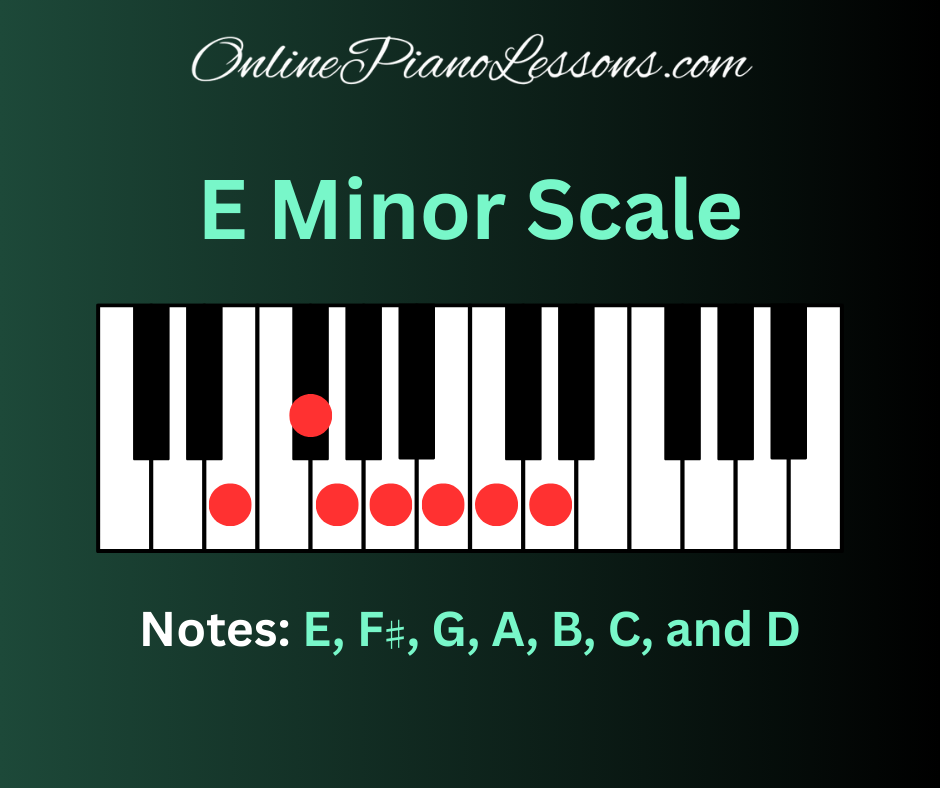
If you want a scale that’s both heartbreakingly beautiful and endlessly useful, the e minor scale is where many musicians start. It’s a staple in classical repertoire, a favorite in folk and rock, and an essential building block for improvisation. This definitive guide covers everything you need to know about the e minor scale: the different forms, note spellings, fingerings for piano, harmony, practice routines, musical uses, and a short FAQ to answer the most common questions.
What is the e minor scale?
The e minor scale is a seven-note scale built on E as the tonic. It’s the relative minor of G major, which means it shares the same key signature (one sharp: F♯). In its most common (natural) form, the e minor scale produces a melancholic, introspective sound that composers and songwriters use when they want emotional depth without excessive darkness.
There are three main versions you’ll see and use regularly:
- E natural minor (the basic form of the e minor scale)
- E harmonic minor (raises the 7th for stronger cadences)
- E melodic minor (raises the 6th and 7th ascending for smoother melodies)
Each variation of the e minor scale has its own sound and function in music; learning all three gives you maximum expressive flexibility.
The notes (spellings) of the e minor scale
Here are the exact notes for each common form of the e minor scale:
E Natural Minor (Aeolian) — the baseline e minor scale:
E – F♯ – G – A – B – C – D – E
E Harmonic Minor — raised 7th (D → D♯):
E – F♯ – G – A – B – C – D♯ – E
E Melodic Minor (classical) — raised 6th and 7th ascending (C → C♯, D → D♯), revert to natural minor descending:
Ascending: E – F♯ – G – A – B – C♯ – D♯ – E
Descending: E – D – C – B – A – G – F♯ – E
In jazz practice, the ascending melodic form is often used in both directions — so expect to see E melodic minor used bi-directionally in improvisation contexts.
Why the e minor scale matters (musically)
-
Emotion & color: The e minor scale gives a plaintive, warm minor flavor without the heaviness of lower-register keys.
-
Relative major link: Because the e minor scale shares a key signature with G major, the two keys are easy to pivot between in arrangements.
-
Improvisation foundation: The different forms of the e minor scale supply melodic choices over minor and dominant chords (natural for modal work, harmonic for cadences, melodic for smooth lines).
-
Technique & reading: Learning the e minor scale builds dexterity for F♯ and helps you master common harmonic movement in tonal music.
Fingerings for piano — practical suggestions
Here’s reliable fingering for two-octave scale practice. Use these as the default and only modify when a piece’s context requires it.
E Natural Minor (two octaves) — Right Hand (RH)
Ascending: 1 – 2 – 3 – 1 – 2 – 3 – 4 – 1 – 2 – 3 – 1 – 2 – 3 – 4
Descending: reverse the pattern slowly and evenly.
E Natural Minor — Left Hand (LH)
Ascending: 5 – 4 – 3 – 2 – 1 – 3 – 2 – 1 – 5 – 4 – 3 – 2 – 1 – 3
Descend the opposite way.
E Harmonic & Melodic Minor
Use the same fingering patterns for harmonic and melodic variants — the finger numbers don’t change, only the accidentals do. For melodic minor, pay special attention to the raised 6th (C♯) and raised 7th (D♯) when ascending; separate-hand slow practice first avoids surprises.
Tip: keep your wrist flexible, thumbs light, and fingers rounded — the e minor scale should flow, not clench.
Chords and harmony in E minor
Understanding the harmony that comes from the e minor scale is crucial for composition and improvisation.
Diatonic triads in E natural minor (i → VII):
- i: E minor (E–G–B)
- ii°: F♯ diminished (F♯–A–C)
- III: G major (G–B–D)
- iv: A minor (A–C–E)
- v: B minor (B–D–F♯)
- VI: C major (C–E–G)
- VII: D major (D–F♯–A)
If you use the e harmonic minor form (D → D♯), the dominant chord becomes B major (B–D♯–F♯), which creates a much stronger pull back to E minor — that’s why composers raise the 7th for cadences. The e melodic minor (with C♯ and D♯ ascending) offers richer melodic options and altered chord possibilities often used in jazz.
Practicing the e minor scale — a 20-minute routine
Here’s a practical daily routine to internalize the e minor scale:
- Warm-up (3 min): Single-octave E natural minor, hands separately, slow.
- Two-octave hands-separate (5 min): Legato, metronome at ♩=60; focus on evenness.
- Two-octave hands-together (5 min): Straight, then dotted rhythm to fix balance.
- Harmonic & Melodic (4 min): One octave harmonic minor RH, melodic minor ascending LH; switch and repeat.
- Musical application (3 min): Play I–iv–V(i) or improvise a short melody using the e minor scale.
Repeat this 5–6 days a week; the e minor scale will become second nature.
Modes and related scales
The e minor scale (natural minor) is also called E Aeolian. Other modes starting on E produce different flavors:
- E Dorian: E F♯ G A B C♯ D (brighter minor with major 6th)
- E Phrygian: E F G A B C D (darker, with flat 2)
- E Aeolian: the e minor scale (E F♯ G A B C D)
Knowing modal relatives helps you switch moods quickly: using E Dorian instead of the e minor scale instantly spices up improvisations with a more hopeful minor color (C♯ instead of C).
Using the e minor scale musically
- Improvisation: Start on chord tones (E/G/B on Em) and use passing tones from the e minor scale. Switch to harmonic minor over a B7 (dominant) chord for stronger resolution.
- Songwriting: Use the e minor scale for verses and move to relative G major for choruses to lift the mood.
- Arrangement tip: Basslines that outline the e minor scale (E → B → A → G) give a strong yet simple underpinning for folk/pop songs.
Famous uses & repertoire (examples)
- Chopin — Prelude in E minor, Op. 28 No. 4 — a compact study in melancholy built around the e minor scale.
Listening to pieces in E minor while following the scale on your instrument will sharpen your ear for how composers use the different scale forms.
Common problems & fixes
- Uneven crossings: If the thumb causes a bump at the pass-under, slow down and practice thumb-under lightly — repeat in short bursts.
- Accidental mistakes (F♯ vs F): Say note names while playing slowly to reinforce the F♯ in the e minor scale.
- Tension at speed: Relax shoulders and forearms; practice at a slower tempo with clean tone before speeding up.
- Modal confusion: If improvisations sound off, check whether the backing chords imply natural, harmonic, or melodic minor — choose your e minor scale variant to match.
Quick theory cheat-sheet
- Key signature: 1 sharp (F♯) — same as G major.
- Relative major: G major.
- Parallel major: E major (four sharps).
- Primary chords in E minor: Em (i), Bm or B (v/V if harmonic), G (III).
Final thoughts
The e minor scale is simple to learn yet rich in musical potential. Whether you’re a pianist practicing finger independence, a guitarist writing a moody riff, or a songwriter searching for the right emotional palette, the e minor scale gives you a flexible, expressive toolkit. Practice it slowly, use it musically, and fold its variations into your playing — you’ll find that the e minor scale opens up more musical doors than you expected.
FAQ — e minor scale
Q1: What notes are in the e minor scale?
A: The e minor scale (natural) is E, F♯, G, A, B, C, D, E. If you use harmonic minor, the 7th is raised to D♯; melodic minor raises 6th and 7th ascending (C♯ and D♯).
Q2: Which version of the e minor scale should I learn first?
A: Start with the natural e minor scale to internalize the key signature and common triads; add harmonic and melodic minor as you work on cadences and melodic lines.
Q3: How do I improvise using the e minor scale?
A: Begin on chord tones (especially the root, 3rd, and 5th), use passing notes from the e minor scale, and switch to harmonic or melodic forms when the harmony asks for a stronger leading tone (e.g., over B7).
Q4: What’s a simple practice goal for the e minor scale?
A: Practice two octaves hands together at a steady tempo, 5 days a week. Add harmonic and melodic forms twice a week and do short improvisations using only e minor scale tones.

 Get Full Access (Only $5/mo)
Get Full Access (Only $5/mo)



 I love playing piano, creating new melodies and songs, and further developing my online piano course and making updates/additions to my site OnlinePianoLessons.com!
I love playing piano, creating new melodies and songs, and further developing my online piano course and making updates/additions to my site OnlinePianoLessons.com!  Now that is what I call fun!
Now that is what I call fun!





